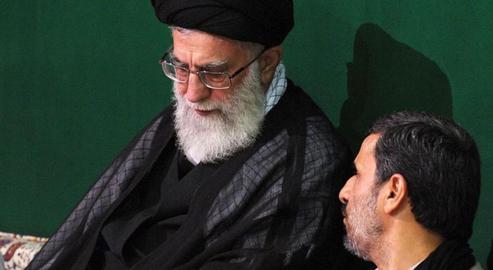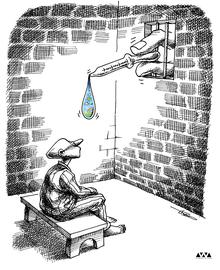Throughout his political career, Mahmoud Ahmadinejad has often come across as a rebel. But he has also been loyal, obeying the orders of three key figures — and has consistently been rewarded for it. He followed the orders of former president Akbar Hashemi Rafsanjani, who appointed Ahmadinejad as governor of Ardabil province in 1993. He was loyal to influential principlist cleric and former chairman of the Guardian Council Ahmad Jannati, who appointed him as a special inspector for the council’s elections and then supported his successful bid to become Tehran’s mayor in 2003. And he was obedient to the Supreme Leader Ayatollah Ali Khamenei, who was responsible for Ahmadinejad being president for two terms and then later ensured he became a member of the Expediency Council, which has the power to arbitrate among all branches of government.
But these loyalties have not always stayed in tact. A decade after working with Rafsanjani, Ahmadinejad turned into his top political opponent. He seemed to believe that Rafsanjani was like a little piece of bone stuck in throat of the revolution and that it was everyone’s duty to help extract him so that the revolution could breathe again. When Rafsanjani died, it was President Hassan Rouhani who replaced Rafsanjani as Ahmadinejad’s bête noire. In a recent visit to Ahvaz he made his animosity clear, inviting an audience to do their best to “bury the Satan in Iran.”
But the animosity between Ahmadinejad and Jannati evolved at a much quicker pace than that between Rouhani and Ahmadinejad. The trigger for this fallout was the famous Mashaei affair in the summer of 2009. Ahmadinejad had appointed Esfandiar Rahim Mashaei, who was unpopular with the ruling clergy because of his nationalistic and unorthodox religious views, as his first vice president — going against the wishes of the Supreme Leader. Ahmadinejad chose to disregard private warnings from Khamenei, forcing the supreme leader to publicly veto the appointment. On July 31, 2009, during a sermon at Tehran Friday Prayers, Jannati rebuked Ahmadinejad, saying that some of his recent decisions had been a “source of anger for the people” and reminding him that “it is the supreme leader who grants legitimacy to officials.”
Not Even Over my Dead Body!
But Ahmadinejad was obstinate in his support for Mashaei, and wanted him to succeed him as president. Immediately after Khamenei forced Mashaei to resign as first vice president, Ahmadinejad appointed him as his chief of staff. Following the disputed 2009 presidential election, he started a campaign to ensure Mashaei qualified as a candidate for the 2013 presidential election. He even asked Jannati, the head of the Guardian Council, to give Mashaei a chance to meet with him so that any “misunderstandings” could be cleared up. Jannati responded with brisk sarcasm [Persian link]: “Meaning that I, too, should become notorious for meeting with Mr. Mashaei?” It was an obvious reference to Mashaei’s unpopularity among conservative factions in Iran — and with the Supreme Leader.
Mashaei was then quoted as saying that Jannati, who was born in 1927, would not be alive in 2013 to disqualify him. Jannati retaliated. “Even if were to die my successor would not qualify you,” he said. As it happened, Jannati was still alive in 2013 and of course disqualified Mashaei from running.
This was just the start of Ahmadinejad’s intransigency toward Ayatollah Khamenei and his supporters. In April 2011, Ahmadinejad called for the resignation of Intelligence Minister Heydar Moslehi as part of his plan to gain control over one of the most jealously-guarded positions in the Islamic Republic. Again he ignored Khamenei’s warnings, again resulting in the supreme leader going public. On April 17, Khamenei publicly refused to accept the resignation of Moslehi. Ahmadinejad responded by confining himself to his home and refusing to attend cabinet sessions or any other public meetings or religious ceremonies. In exchange for his public show of displeasure with the Supreme Leader, Ahmadinejad was met with condemnation from across the conservative political spectrum, calls from some parliamentarians for his impeachment and Friday Prayers’ diatribes from Ahmad Jannati that severed the last vestiges of friendship between the two.
Only Seven Short Years
So will relations between Mahmoud Ahmadinejad and Ayatollah Khamenei end the same way?
It was in 2004 that Khamenei began to notice Mayor Ahmadinejad’s eagerness to please him. And it was in 2011 that his anger boiled over when President Ahmadinejad tried to publicly snub him — so good relations between the two lasted a relatively short time. Throughout these seven years, it was not only Hashemi Rafsanjani who repeatedly warned Ahmadinejad or showed signs of wanting to get rid of him.
Before the 2009 presidential election got underway, Ali Motahari, a member of the parliament who represents Tehran, called for principlist conservatives to support former Foreign Minister Ali Akbar Velayati in his bid for the presidency. His plan was that the principlists would unseat Ahmadinejad, and not the reformists. But the majority of the principlists he appealed to did respond because they knew Khamenei believed that only Ahmadinejad could win against reformist candidate Mir Hossein Mousavi. Even after the contested official results declared Ahmadinejad the winner, some principlists refused to change their stance. According to the former national police chief Esmail Ahmadi [Persian link], they hoped the results would be declared invalid so that neither Ahmadinejad nor Mir Hossein Mousavi would become president. “Anybody is better than these two,” seemed to be their view — but Khamenei vetoed the idea.
Be Careful When Choosing Enemies
After the election, in the fall of 2010, Mohammad Yazdi, the former Chief Justice of Iran, and the influential teachers of Qom Seminary met privately with Ayatollah Khamenei to express their concerns about Ahmadinejad. But the Supreme Leader told them Ahmadinejad should remain in power because he would not create a “dual sovereignty” or incite competition between Iran’s most powerful factions. “Today when the president or a high government official travels abroad I don’t have to worry,” he told them.
These accounts show that during those seven years, Khamenei did his utmost to support Ahmadinejad. But things changed in April 2011 when Ahmadinejad confined himself to his home in protest against Khamenei’s refusal to allow him to appoint a new intelligence minister.
In 2010, another very public battle began between Ahmadinejad and the influential Larijani brothers — Parliament Speaker Ali Larijani, Judiciary Chief Sadegh Larijani and Mohammad Javad Larijani, also a judiciary official. When the parliament took steps to impeach Labor Minister Abdolreza Sheikholeslam, Ahmadinejad went to parliament to forestall the process. He accused Ali Larijani and his fellow lawmakers of obstructing the government and violating the constitution. Regardless, his labor minister was impeached and removed.
The feud continued well into 2013, with Ahmadinejad accusing Sadegh Larijani of protecting corrupt officials. In February of that year Ahmadinejad released audio recordings that he claimed proved the fraudulent business deals had taken place. And this time, Khamenei took the side of the Larijani brothers. When the the Guardian Council disqualified Mashaei from running, Khamenei did not lift a finger to save him. Furthermore, he began to politely sideline Ahmadinejad from big political decisions, including the matter of the nuclear program.
Ahmadinejad was supposed to be one of Khamenei’s big success stories, but he ended up infuriating the supreme leader, and eventually even forging the divides Khamenei hoped he would stave off. When Ahmadinejad’s presidency draw to a close, conservatives and even the Revolutionary Guards were fractured and balkanized, big projects were inefficiently handled, popular discontent was high, Iran was internationally isolated, the 2009 presidential election had ended in a virtual coup d’état, the prestige of Khamenei had been badly damaged... and the list goes on.
Since the end of his presidency, Ahmadinejad has not really changed. He continues to disregard Ayatollah Khamenei’s wishes. In September 2016, Khamenei “explicitly forbid” him from putting himself forward as a candidate in Iran’s 2017 presidential election. On February 11, 2017, Ahmadinejad issued a statement [Persian link] announcing that he would not be supporting any candidate in the upcoming presidential election. However, this promise turned out to be a mere formality. Instead, he vigorously supports his former deputy, Hamid Baghaei, who announced his candidacy just days after Ahmadinejad's own announcement.
Temper Tantrums Without a Backbone
Throughout the history of the Islamic Republic, political figures have repeatedly picked fights with the Supreme Leader, so Ahmadinejad is not unique. But the question is: how far is he willing to go? The 2009 presidential candidate Mir Hossein Mousavi challenged the Supreme Leader by not yielding to his wishes that he accept the official results of the election. He stood his ground and has been paying the price ever since. He remains under house arrest to this day.
But while Ahmadinejad has picked very visible fights with Khamenei over the last six years, he has always surrendered. As the MP Ali Motahari once said, Ahmadinejad stands up to his opponents but gives up when he finds it necessary. This, however, is not a sign of his intelligence. Rather, it reveals both his fear and his desperation.
In 2017, Ahmadinejad has no support in the upper echelons of Iran’s political power structure. He does enjoy some residual support from Ayatollah Khamenei — if this was not true, then Sadegh Larijani would have been able to completely destroy him. He appears to be obstinate but then never actually stays firm when a situation or crisis is coming to an end. In other words, he throws dramatic temper tantrums but has shown that he does not have the backbone to stand by his assertions.
The most recent confrontation between Ahmadinejad and the Supreme Leader could benefit Khamenei. He is in a position to issue a few more warnings to help smooth over the damage done over the last decade. The recent battle could also give President Rouhani a chance to demonstrate that Khamenei does actually trust him and that the two of them are close. And the principlists can announce to the world that they are getting rid of Ahmadinejad once and for all.
But all of this might not matter to the Iranian people. Not only are they tired of Ahmadinejad, they are also probably fed up with Khamenei, the conservative principlists and even Rouhani and the reformists.
It is fair to say that while Ahmadinejad was president, the lives of Iranians were not improved. But it’s also true that the all the other on-going battles in Iranian political life have failed to produce any benefits either — and no amount of posturing or dramatic power struggles can change this.
visit the accountability section
In this section of Iran Wire, you can contact the officials and launch your campaign for various problems

























comments